- ホーム
- > 洋書
- > 英文書
- > Computer / Databases
Full Description
Describes the State-of-the-Art in Spatial Data Mining, Focuses on Data Quality
Substantial progress has been made toward developing effective techniques for spatial information processing in recent years. This science deals with models of reality in a GIS, however, and not with reality itself. Therefore, spatial information processes are often imprecise, allowing for much interpretation of abstract figures and data. Quality Aspects in Spatial Data Mining introduces practical and theoretical solutions for making sense of the often chaotic and overwhelming amount of concrete data available to researchers.
In this cohesive collection of peer-reviewed chapters, field authorities present the latest field advancements and cover such essential areas as data acquisition, geoinformation theory, spatial statistics, and dissemination. Each chapter debuts with an editorial preview of each topic from a conceptual, applied, and methodological point of view, making it easier for researchers to judge which information is most beneficial to their work.
Chapters Evolve From Error Propagation and Spatial Statistics to Address Relevant Applications
The book advises the use of granular computing as a means of circumventing spatial complexities. This counter-application to traditional computing allows for the calculation of imprecise probabilities - the kind of information that the spatial information systems community wrestles with much of the time.
Under the editorial guidance of internationally respected geoinformatics experts, this indispensable volume addresses quality aspects in the entire spatial data mining process, from data acquisition to end user. It also alleviates what is often field researchers' most daunting task by organizing the wealth of concrete spatial data available into one convenient source, thereby advancing the frontiers of spatial inf
Contents
Granular Computing - Computing with Uncertain, Imprecise, and Partially True Data, Systems Approaches to Spatial Data Quality. Querying Vague Spatial Objects in Databases with VASA. Assessing the Quality of Data with a Decision Model. Semantic Reference Systems Accounting for Uncertainty: A Requirements Analysis. Elements of Semantic Mapping Quality: A Theoretical Framework. A Multicriteria Fusion Approach for Geographical Data Matching. Geostatistics and Spatial Data Quality for DEMs. A Preliminary Study on Spatial Sampling for Topographic Data. Predictive Risk Mapping of Water Table Depths in a Brazilian Cerrado Area. Modeling Data Quality with Possibility Distributions. A Comparison of Geostatistics and Fuzzy Applications for Digital Elevation Models. Error Propagation. Propagation of Positional Measurement Errors to Field Operations. Error Propagation Analysis Techniques Applied to Precision Agriculture and Environmental Models. Aspects of Error Propagation in Modern Geodetic Networks. Analysis of the Quality of Collection 4 and 5 Vegetation Index Time Series from MODIS. Modeling DEM Data Uncertainties for Monte Carlo Simulations of Ice Sheet Models. Applications. Geostatistical Texture Classification of Tropical Rainforest in Indonesia. Quality Assessment for Polygon Generalization. Effectiveness of High-Resolution LIDAR DSM for Two-Dimensional Hydrodynamic Flood Modeling in an Urban Area. Uncertainty, Vagueness, and Indiscernibility: The Impact of Spatial Scale in Relation to the Landscape Elements. A Quality-Aware Approach for the Early Steps of the Integration of Environmental Systems. Analyzing and Aggregating Visitor Tracks in a Protected Area. Communication. What Communicates Quality to the Spatial Data Consumer? Judging and Visualizing the Quality of Spatio-Temporal Data on the Kakamega-Nandi Forest Area in West Kenya. A Study on the Impact of Scale-Dependent Factors on the Classification of Landcover Maps. Formal Languages for Expressing Spatial Data






